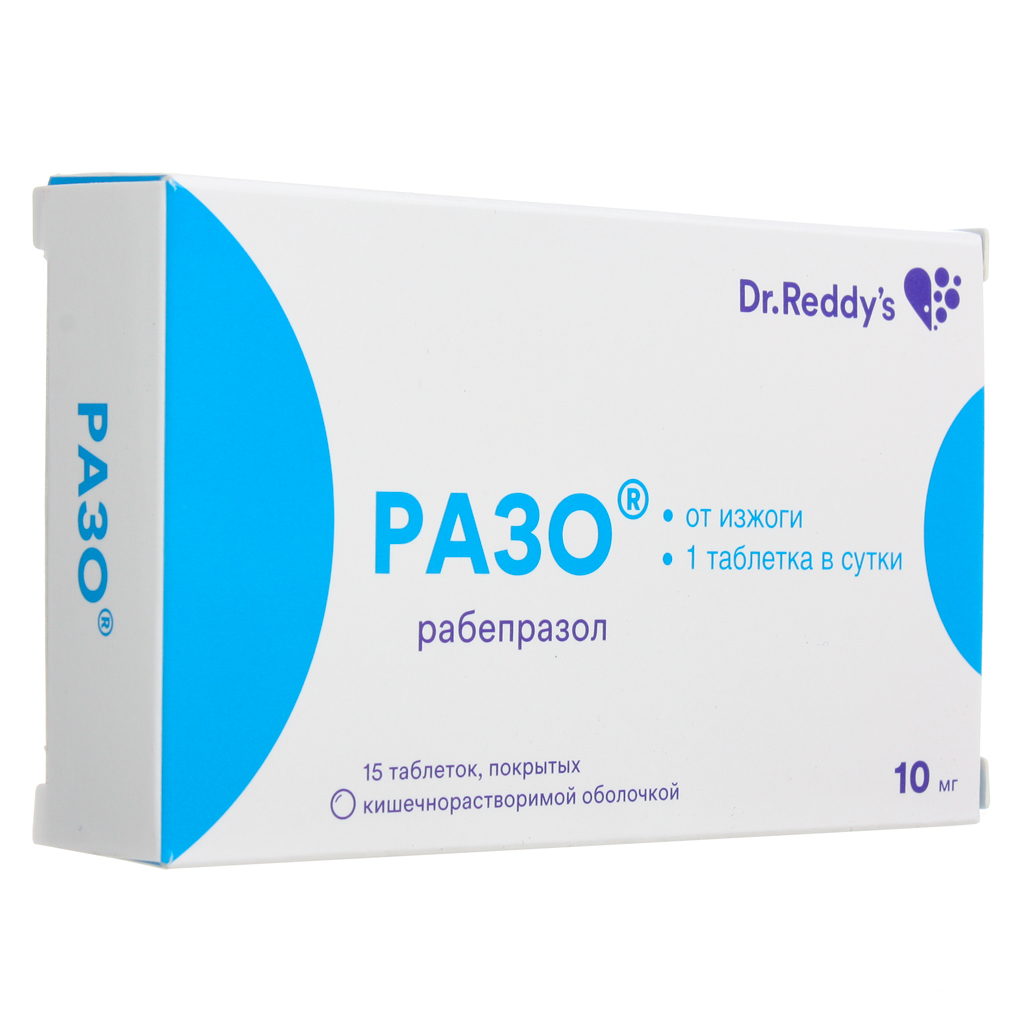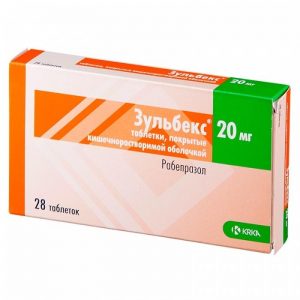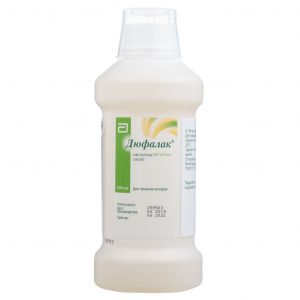Description
Pharmacological action
Pharmacokinetics
Absorption
Absorbed quickly Cmax in plasma is achieved approximately 3.5 hours after taking the drug at a dose of 20 mg. Changes in plasma Cmax and AUC values ​​of rabeprazole are linear in the range of doses from 10 to 40 mg. Absolute bioavailability after oral administration in a dose of 20 mg (compared with iv) is about 52%. In addition, bioavailability does not change with multiple doses of rabeprazole. Neither the time of taking the drug during the day, nor antacids affect the absorption of rabeprazole. Taking the drug with fatty foods slows down the absorption of rabeprazole for 4 hours or more, however, neither Cmax nor the degree of absorption change.
Distribution of
The degree of binding of rabeprazole to plasma proteins is about 97%.
Metabolism
Rabeprazole is metabolized in the body in two ways. A significant part of it is metabolized systemically non-enzymatically with the formation of thioether derivatives. Rabeprazole is also metabolized in the liver via cytochrome P450 to form sulfonic and desmethyl derivatives.
Excretion of
In healthy volunteers, T1 / 2 from plasma is about 1 hour (varies from 0.7 to 1.5 hours), the total clearance is 3.8 ml / min / kg.
After a single oral administration of 20 mg of 14C-labeled rabeprazole, about 90% of the drug is excreted in the urine, mainly in the form of a carbon thioether 8 ml / min / kg.
After a single oral administration of 20 mg of 14C-labeled rabeprazole, about 90% of the drug is excreted in the urine, mainly in the form of a carbon thioether 8 ml / min / kg.
After a single oral administration of 20 mg of 14C-labeled rabeprazole, about 90% of the drug is excreted in the urine, mainly in the form of a carbon thioetherhydrochloric acid, its glucuronide and in the form of derivatives of mercapturic acid. An unchanged drug in the urine is not detected. The remainder of rabeprazole taken is excreted through the intestines. The total elimination is 99.8%.
Pharmacokinetics in special patient groups
In patients with stable renal insufficiency in the terminal stage who require maintenance hemodialysis (CC
Patients with chronic compensated liver cirrhosis tolerate rabeprazole at a dose of 20 mg 1 time / day, although AUC is doubled and Cmax is increased by 50 % compared with healthy volunteers.
In elderly patients, elimination of rabeprazole is somewhat slowed down. After 7 days of taking rabeprazole in a dose of 20 mg 1 time / day in elderly people, the AUC was about twice as much and Cmax increased by 60% compared with young healthy volunteers there were no signs of cumulation of the drug.
In patients with a slow metabolism through the CYP2C19 isoenzyme, after 7 days of taking rabeprazole at a dose of 20 mg / day, AUC increases by 1.9 times, and T1 / 2 by 1.6 times compared to the same parameters in fast metabolizers, while Cmax increases by 40%
Pharmacodynamics
Mechanism of Action
Rabeprazole belongs to the class of antisecretory compounds that are chemically substituted benzimidazoles. The drug inhibits the activity of the enzyme H + -K + -ATPase (proton pump), thereby blocking the final stage of hydrochloric acid synthesis. This effect is dose-dependent in nature and leads to inhibition as basal, and stimulated secretion of hydrochloric acid, regardless of the stimulus. As a weak base, rabeprazole in any dose is rapidly absorbed and concentrated in the acidic environment of parietal cells.
Antisecretory activity of
After oral administration of rabeprazole at a dose of 20 mg, the antisecretory effect develops within 1 hour. Inhibition of basal and stimulated secretion of hydrochloric acid 23 hours after taking the first dose of rabeprazole sodium is 62% and 82%, respectively, and lasts up to 48 hours. the duration of the pharmacokinetic effect is much higher than that predicted for T1 / 2, which is about 1 hour. This effect is probably due to the binding of the drug substance to the H + -K + -ATPase of the parietal cells dka. The value of the inhibitory effect of rabeprazole sodium on acid secretion reaches a plateau after 3 days of taking rabeprazole sodium. When you stop taking secretory activity is restored within 1-2 days.
Effect on the concentration of gastrin in the blood serum
At the beginning of rabeprazole therapy, the concentration of gastrin in the blood serum increases, which is a reflection of the inhibitory effect on the secretion of hydrochloric acid. The concentration of gastrin returns to its initial level, usually within 1-2 weeks after discontinuation of treatment.
Effect on enterochromaffin-like cells
The study of biopsy samples of the bottom and antrum of the stomach in more than 500 patients treated with rabeprazole sodium or a comparison drug for up to 8 weeks did not reveal changes in the morphological structure of enterochromaffin-like (ECL) cells, the severity of gastritis, the frequency of atrophic gastritis, intestinal metaplasia, or the prevalence of Helicobacter pylori infection.
In a study of more than 400 patients receiving rabeprazole at a dose of 10 mg / day or 20 mg / day for up to 1 year, the incidence of hyperplasia was low and comparable to that of patients receiving omeprazole at a dose of 20 mg / day. There were no cases of adenomatous changes or carcinoid tumors observed in rats.
Other effects of
There is currently no evidence that rabeprazole causes systemic effects on the central nervous system, cardiovascular and respiratory systems. When taken orally at a dose of 20 mg for 2 weeks, rabeprazole had no effect on thyroid function, carbohydrate metabolism, and also on the concentration in the blood of parathyroid hormone, cortisol, estrogen, testosterone, prolactin, secretin, glucagon, FSH, LH, renin, aldosterone and somatotropic hormone.
Indications
Symptoms of dyspepsia associated with increased acidity of gastric juice, incl. symptoms of gastroesophageal reflux disease (heartburn, sour belching).
Contraindications
pregnancy
period of breastfeeding (lactation)
children under 18 years of age
hypersensitivity to rabeprazole, substituted benzimidazoles or to auxiliary components of the drug.
Caution: severe renal failure.
Composition
Active ingredients:
Rabeprazole sodium – 10 mg
Excipients:
Mannitol 48.505 mg
Hyprolose low substituted 7.20 mg
Magnesium oxide heavy 20.00 mg
Sulflum 5gpromsperlum 90mg
Talc 0.77 mg
Magnesium stearate 1.125 mg
Shell composition:
Zein 2.45 mg
Triethyl citrate 0.25 mg
Enteric shell composition:
Methacrylic acid and ethyl acrylate copolymer (type: [1: C)) 12.05 mg
Triethyl citrate 1.20 mg, talc 0.65 mg
Shell composition: srdl kp Opadry pink O3B54475 2.70 mg (hypromellose 6cP 62.50%, titanium dioxide (E171) 28.70%, macrogol-400 6.25%
Iron dye oxide red (E172) 2, 55%)
Composition of black ink for inscribing on a tablet:
Shellac glaze (45%) 59.0%
Charming red dye (Е129) 15.0%
N-butanol 7.0%
Ethanol denatured 6.0%
Titanium dioxide (E171) 5.0%
Propylene glycol 4.0%
Isopropyl alcohol 3.0%
Ammonia solution concentrated 28% – 1.0%
Dosage and administration of
The drug is taken orally at a dose of 10 mg (1 tab.) 1 time / day.
Tablets should be swallowed whole without chewing or crushing.
It is recommended to use the drug in the morning, before eating.
It is established that neither time of day, food intake does not affect rabeprazole activity, but the recommended time to take RazoВ® tablets helps patients to better adhere to the treatment regimen.
If there is no effect during the first 3 days of treatment, a specialist examination is necessary. the maximum course of treatment without consulting a doctor is 14 days.
Side effects
Rabeprazole is usually well tolerated by patients.
Side effects are generally mild or moderate and are transient.
When taking rabeprazole during clinical trials, the following side effects were noted: headache, abdominal pain, diarrhea, flatulence, constipation, dry mouth, dizziness, rash, peripheral edema.
The frequency of side effects is described in accordance with the following gradation:
very often (> 1/10)
often (1 / 10-1 / 100)
infrequently (1 / 100-1 / 1000)
rarely (1 / 1000- 1/10 000)
very rare (
From the immune system:
rarely – acute systemic allergic reactions.
From the hematopoietic system:
rarely – thrombocytopenia, neutropenia, leukopenia.
Metabolism:
rarely – hypomagnia. From the hepatobiliary system:
rarely – increased activity of hepatic enzymes, hepatitis, jaundice, hepatic enceph . Shovel
From the urinary system:
very rarely – interstitial nephritis
Skin and subcutaneous tissue disorders:
rare – bullous rash. urticaria
very rarely – erythema multiforme, toxic epidermal necrolysis, Stevens-Johnson syndrome
From the musculoskeletal system:
rarely – myalgia, arthralgia.
From the genitals and mammary gland:
is very rare – gynecomastia.
Changes in other laboratory parameters during the administration of rabeprazole sodium were not observed.
When taking proton pump inhibitors, you may increase the risk of bone fractures.
Drug interaction
Cytochrome 450 system
Rabeprazole, like other proton pump inhibitors (PPIs), is metabolized by the liver cytochrome P450 system (CYP450). In vitro studies on human liver microsomes have shown that rabeprazole is metabolized by the isoenzymes CYP2C19 and CYP3A4.
Studies in healthy volunteers have shown that rabeprazole has no pharmacokinetically or clinically significant interaction with drugs that are metabolized by the P450 cytochrome system – warfarin, phenytoin, theophylline and diazepam (regardless of whether patients metabolize diazepam intensely or weakly).
A study of combination therapy with antibacterial drugs. This four-way cross-sectional study involved 16 healthy volunteers who received 20 mg of rabeprazole, 1000 mg of amoxicillin, 500 mg of clarithromycin, or a combination of these three drugs (RAC – rabeprazole, amoxicillin, clarithromycin).
AUC and Cmax for clarithromycin and amoxicillin were similar when comparing combination therapy with monotherapy. AUC and Cmax for rabeprazole increased by 11% and 34%, respectively, and for 14-hydroxy-clarithromycin (an active metabolite of clarithromycin), AUC and Cmax increased by 42% and 46%, respectively, for combination therapy compared with monotherapy. This increase in exposure for rabeprazole and clarithromycin was not recognized as clinically significant.
Interactions due to inhibition of gastric acid secretion
Rabeprazole provides a sustained and sustained suppression of gastric acid secretion. Thus, interactions with substances for which absorption is pH dependent can occur. With simultaneous administration with rabeprazole, the absorption of ketoconazole is reduced by 30%, and the absorption of digoxin is increased by 22%. Therefore, some patients should be monitored to address the need for dose adjustment while using rabeprazole with ketoconazole, digoxin, or other drugs for which the absorption depends on pH.
Atazanavir
With concomitant use of atazanavir 300 mg / ritonavir 100 mg with omeprazole (40 mg 1 time / day) or atazanavir 400 mg with lansoprazole (60 mg 1 time / day), healthy volunteers showed a significant decrease in the effects of atazanavir. Atazanavir absorption is pH dependent. Although concurrent administration with rabeprazole has not been studied, similar results are also expected for other proton pump inhibitors. Thus, the simultaneous use of atazanavir with proton pump inhibitors, including rabeprazole, is not recommended.
Antacids
In clinical trials, antacids were used in conjunction with rabeprazole. No clinically significant interaction of rabeprazole with aluminum hydroxide gel or magnesium hydroxide was observed.
Food intake
In a clinical study, no clinically significant interaction was observed with rabeprazole and a low-fat diet. Reception of rabeprazole along with a diet rich in fats can slow down the absorption of rabeprazole for 4 hours or more, however, Cmax and AUC do not change.
Cyclosporin
In vitro experiments using human liver microsomes have shown that rabeprazole inhibits cyclosporin metabolism with an IC50 of 62 Ојmol, i.e. at a concentration 50 times higher than Cmax for healthy volunteers after 20 days of taking 20 mg of rabeprazole. The degree of inhibition is similar to that for omeprazole at equivalent concentrations.
Methotrexate
According to reports of adverse events, published pharmacokinetic studies, and retrospective analysis, it can be assumed that the simultaneous administration of PPI and methotrexate (primarily in high doses) can lead to an increase in the concentration of methotrexate and / or its metabolite hydroxymethotrexate and increase T1 / 2. However, special studies of the drug interaction of methotrexate with PPI have not been conducted.
active substance
rabeprazole
Conditions of supply of pharmacies
without prescription
dosage form
tablets




